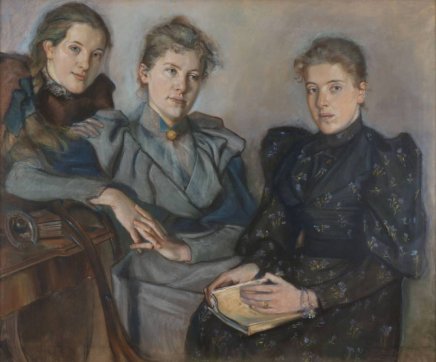Wyspiański. Afterword
17.05-06.10.2019
The “Wyspiański. Afterword” exhibition will show new, little known works of The Wedding’s author and his students – inheritors of his ideas.
They complete the space of the two “libraries”, already known from the “Wyspiański. Unknown” exhibition, showing the artist’s early works inspired by his reading on the history of art, his innovative editing and typography work, as well as his private collection of books purchased from his widow, Teofila Wyspiańska, maiden name Pytko. Other elements preserved from “Wyspiański. Unknown” exhibition are two spaces, exploring the role of books in the artist’s life: one – with the drawings from Book I of Homer’s Iliad, completed with nineteenth-century publications that inspired Wyspiański, and the other: with the project of Apollo stained glass for Krakow Medical Society House, together with source literature related to ancient art and Pre-Raphaelites’ paintings.
A small room contains fabrics decorated with floral ornaments designed by Wyspiański. These works, which have not been exhibited before, reveal a significant trait of his artistic output: the fascination with folk art.
Colourful batik fabrics are juxtaposed with publications of the turn of the centuries: Poetry by Lucjan Rydel (1901) and Selected works of Maria Konopnicka (1903). Wyspiański designed the graphics of both books, using delicate floral motifs based on folk art paper cutting and embroidery to decorate their pages.
The wall under the mezzanine and the connector exhibit Wyspiański’s oil paintings and drawings from the collection of the NMK, some of which have not been shown before, like the study of a woman in a veil – a project of decoration of Rudolfinum building in Prague (1890-1891), pastel Portrait of Tadeusz Stryjeński’s Children (1894) or the drawings of costumes for Lucjan Rydel’s play Magic Circle (1899). A real discovery is the artist’s new, unknown works, borrowed from private collectors or institutions. One of the most beautiful paintings is the Portrait of the Misses Bober of 1894. This pastel painting, referred to in Wyspiański’s first monography of 1925, was kept outside Poland since the end of World War II.
A separate part of the exhibition, closing the story of Wyspiański, is a small showcase of his students’ works. Stanisław Wyspiański was given the job of an assistant professor of decorative painting at the Academy of Fine Arts in Krakow on 12 April 1902. In the years 1902-1907, the author of “Planty Park at Dawn” taught the following artists: Ignacy Bett (1877-1919), Jan Bulas (1878-1917), Antoni Buszek (1883–1954), , Tytus Czyżewski (1880-1945), Filip Demczuk (1879- ?), Wincenty Drabik (1881-1933), Christo Kutew (1868-1943), Jan Lewicki (1881-?), Wilhelm Mitarski (1879–1923), Tymon Niesiołowski (1882-1965), Jan Rembowski (1879-19230, Stanisław Rzecki (1888-1972), Kazimierz Sichulski (1879–1942), Henryk Uziembło (1879-1949), Michał Żuk (1883 – 1964). They did not only paint but also dealt with graphic and applied art, interior design, scenography, decorating batiks and ceramics, as well as art criticism. The exhibition shows their single works, accompanied by short memories of their great master.
MNK The Main Building
al. 3 Maja 1- Monday: closed
- Tuesday - Sunday: 10.00-18.00